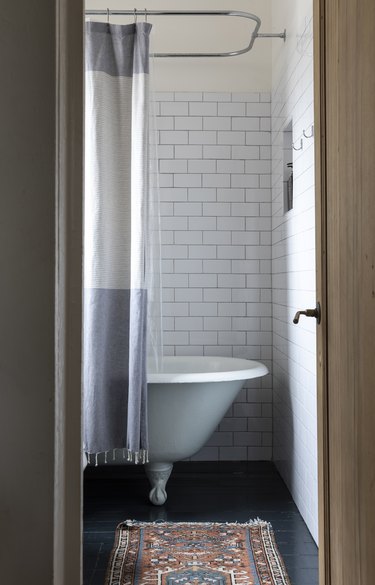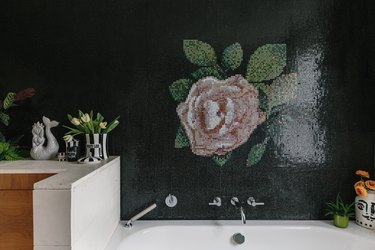Cleaning a bathtub is an important part of household upkeep, and it's something that should be done on a regular basis. From soap scum buildup to hard water deposits, there are a number of different issues that may arise over time. A weekly cleaning will cut down on these problems and help keep any stains and deep cleanings to a minimum. It's helpful to know what approach works best for both a maintenance cleaning and a deep cleaning.
Bathtub Cleaning Basics
Video of the Day
A weekly bathtub cleaning consists of using a mild cleanser to remove the buildup of soap, body oils and other items that begin to accumulate with time and use. After all, if you can keep the tub clean, you may not have to deal as often with issues such as discoloration or mineral deposits. This type of cleaning doesn't have to take hours, but it requires a bit of focus and some basic supplies. How often you use a bathroom will also factor into the cleaning schedule. Some bathtubs may require more care than others.
Video of the Day
Most tubs can be cleaned in the same way during a maintenance cleaning session, and no special cleaners or supplies are needed if you want to go the more natural route. To clean just the tub, American Standard recommends using a spray bottle with a half and half mix of white vinegar and warm water. Leave a couple of inches of water in the tub before spraying it and then let it sit for 20 to 30 minutes before wiping it down and rinsing. This quick and easy method works well and is inexpensive. Be sure to use a soft cloth.
Another easy way to clean a tub is to use a mild dish soap, warm water and a sponge. This method is safe, and it can also help keep soap scum from building up. Just make sure to rinse thoroughly so the tub doesn't become slippery. In addition, there are numerous standard bathroom cleaners on the market that work well to keep tub surfaces free of grime, dirt and soap scum. Just make sure to use a product that is safe for the tub surface (porcelain, acrylic, fiberglass, etc.) and follow the directions for best results.
If you have tile surrounding the area above the tub or if your tub sits on a tiled deck, a different approach may be better. The Tile Council of North America (TCNA) cautions that vinegar isn't a good cleanser to use on grout lines since the cement in most grout can react with the acid in vinegar, causing the grout to break down. In this case, opt for another type of cleaner. The TCNA recommends Spic and Span or Mr. Clean for these situations.
Deep Cleaning a Bathtub
While a weekly cleaning should help keep a bathtub clean, a deep cleaning may be needed periodically if that isn't quite doing the trick. One good way to do this is to pretreat the tub by spreading baking soda over the tub surface and then soaking the area with a half and half mix of white vinegar and warm water. This combo provides a little more scrubbing power and works well for bathtubs that need more than a basic cleaning. As with other methods, be sure to use a nonscratch sponge or cloth to scrub and then rinse well.
Store-bought bathroom cleaning products are another solid option, especially for tackling stubborn tub issues, such as mold and mildew or grime buildup that just won't budge. Tilex and related cleaning brands utilize bleach to kill mold and mildew while whitening grout and cutting through soap scum. These clean caulked areas nicely and eliminate fungus buildup on tile and porcelain tub surfaces. OxiClean can also be a good choice, especially for textured tub floors and colored grout. Be sure to leave some time for OxiClean to soak in for it to work its best.
Formula 409 all-purpose cleaner is a brand that can be used on most acrylic or fiberglass tubs. Another product that works well for fiberglass and acrylic materials is Gel-Gloss. Not only does it clean the surface gently but it also gets rid of oxidation issues, scratches and water spots. In addition, it provides a nice wax finish that helps to further protect these materials and restore a clean bathtub surface area.
Delta suggests using products such as Iron OUT rust stain remover and dishwashing detergent on acrylic tubs. It also cautions against brands such as original Pine-Sol and Simple Green all-purpose cleaner for this particular material. For these tubs, the company recommends checking the label of any cleaner being considered to make sure it doesn't warn against use on acrylic, ABS, polystyrene or plastic.
Spot Cleaning Stubborn Tub Stains
When regular and deep cleaning fail to remove a stain, it's time for stronger measures. Most of the difficult stains on a porcelain tub can be attacked with a paste of baking soda and hydrogen peroxide. Let the paste sit for about an hour and then wipe it off with a soft towel or washcloth. These steps can be repeated if necessary for particularly stubborn stains. Keep in mind that when you are using baking soda, it may require some good scrubbing, and an old toothbrush can work wonders for grouted areas that really need attention.
Different cleaners work for different situations, so be sure to tailor the product to the need. For example, CLR is a popular pick for attacking hard water deposits and limescale and can be safe to use on a variety of bathtub materials. LIME-A-WAY is another option for these issues. Use caution with any surrounding materials if applicable. For example, neither LIME-A-WAY or CLR are recommended for use on colored grouts or natural stone.

Bathtub Cleaning Best Practices
Kohler has a line of bathroom cleaning products that are tailored to specific tub materials to help take the guesswork out of picking the right one for the job, but in general, testing cleaners on a small area is good practice. Be sure to read all of the directions for the product prior to using it and wear gloves to protect your hands from any chemicals. Also keep in mind that ventilation is important when working with these products in an enclosed space, such as a bathroom.
Many tub materials can suffer scratching when aggressive cleaning supplies are used. Avoid materials such as steel wool, brushes with stiff bristles and sponges with abrasive surfaces. Instead, choose old towels, microfiber cloths or nylon sponges for cleaning tub surfaces. Finally, never mix cleaning supplies such as bleach and ammonia or bleach and vinegar because doing so can produce dangerous, toxic fumes.
- Consumer Reports: Cleaning Tips to Make Your Bathroom Sparkle
- American Standard: How to Clean a Bathtub
- Delta: How to Clean Your Acrylic Delta Shower or Tub
- American Standard: Acrylic Shower Bases/Tubs/Whirlpools
- Tile Council of North America: Cleaning Grout
- The Cary Company: CLR Pro Frequently Asked Questions
- Kohler: Care & Cleaning

